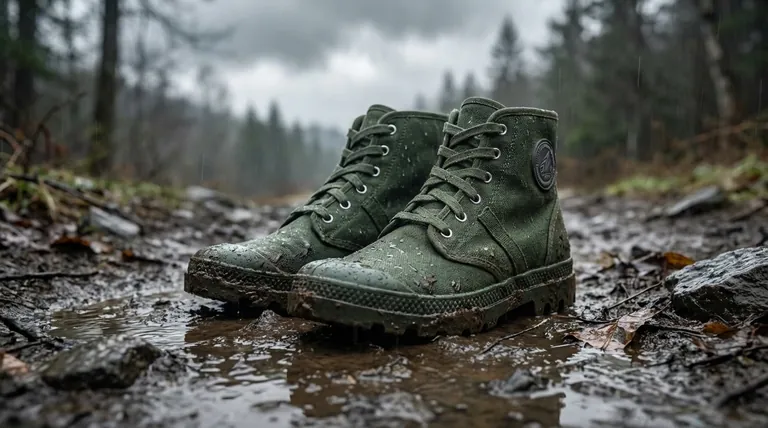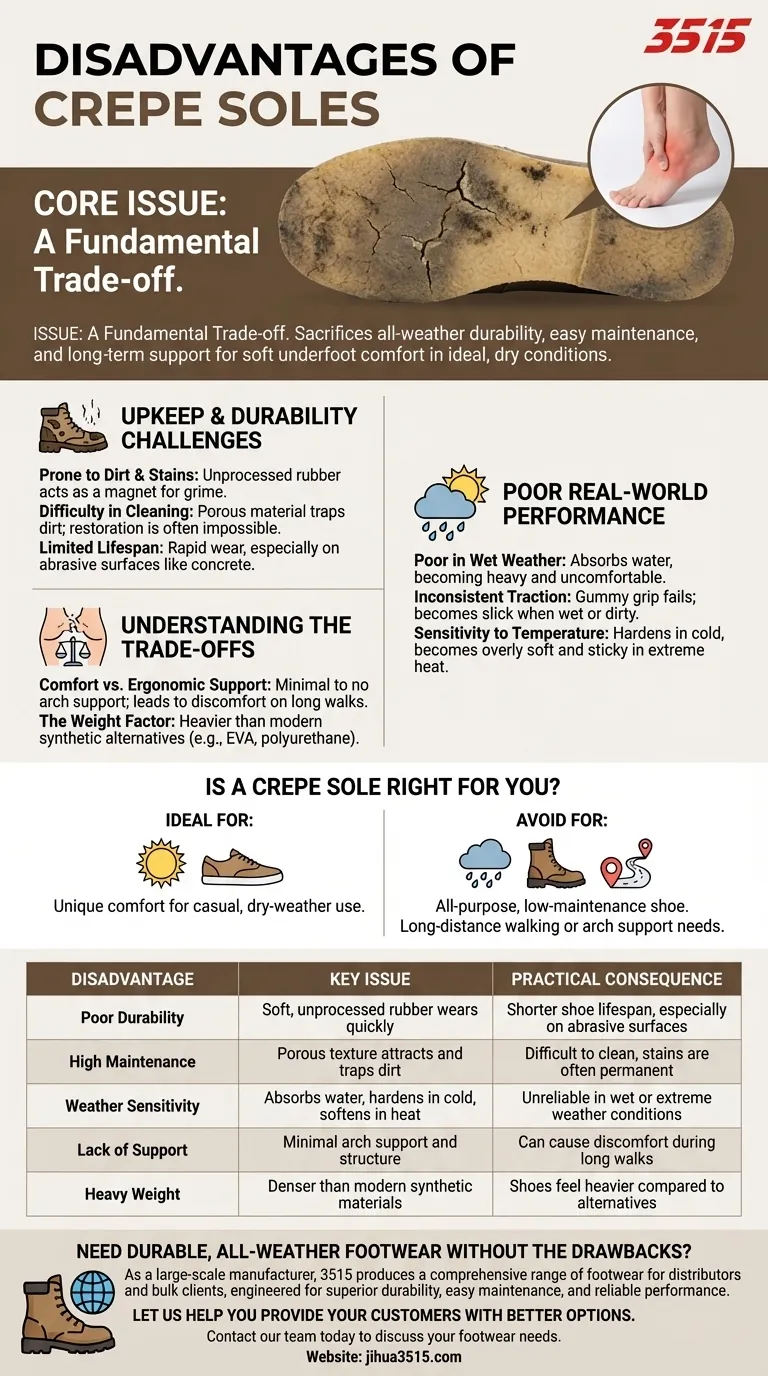The primary disadvantages of crepe soles are their poor durability, susceptibility to dirt and stains, and lack of performance in adverse weather conditions. Made from a soft, unprocessed rubber, they absorb water, offer limited arch support, and can become rigid in the cold or sticky in extreme heat, making them less practical for all-purpose wear.
The core issue with crepe soles is a fundamental trade-off: they sacrifice all-weather durability, easy maintenance, and long-term support for a uniquely soft and flexible underfoot comfort in ideal, dry conditions.

The Challenge of Upkeep and Durability
The distinct, porous texture of a crepe sole is the source of both its unique feel and its greatest maintenance challenges. This material is fundamentally less resilient than its synthetic or vulcanized rubber counterparts.
Prone to Dirt and Stains
The soft, sticky nature of the unprocessed rubber acts like a magnet for dirt, dust, and grime. The light color of most natural crepe soles makes this accumulation immediately obvious.
Difficulty in Cleaning
Unlike a simple wipe-down for a standard rubber sole, cleaning crepe is a significant challenge. Dirt becomes embedded in the porous material, and perfect restoration to its original state is often impossible.
Limited Lifespan
The softness that provides comfort also leads to rapid wear. Crepe soles are not known for their longevity, especially when worn frequently or on abrasive surfaces like concrete.
Performance in Real-World Conditions
A shoe's utility is often defined by its performance across different environments. Crepe soles are highly specialized and falter outside of a narrow set of ideal circumstances.
Poor Performance in Wet Weather
Crepe soles act like a sponge, readily absorbing water. This not only makes the shoe heavy and uncomfortable but also significantly compromises the integrity of the sole and any leather attached to it.
Inconsistent Traction
While the gummy texture can provide a firm grip on clean, dry surfaces, this advantage disappears quickly. When wet or dirty, crepe soles can become slick and lack reliable slip resistance.
Sensitivity to Temperature
The sole's material properties are not stable across temperatures. In extreme heat, it can become overly soft and sticky; in cold weather, it can harden and become uncomfortably rigid.
Understanding the Trade-offs
Choosing a crepe sole means accepting a specific set of compromises. The benefits are centered entirely on feel, while the drawbacks impact practicality and support.
Comfort vs. Ergonomic Support
The signature benefit of a crepe sole is its bouncy, soft, and flexible feel, often compared to wearing a slipper. However, this flexibility comes at the cost of structure.
These soles typically offer minimal to no arch support, which can lead to discomfort and fatigue during long periods of walking for many individuals.
The Weight Factor
Natural crepe rubber is a dense material. Consequently, crepe soles are often heavier than modern synthetic alternatives like polyurethane or EVA foam, which are common in today's trainers and casual shoes.
Is a Crepe Sole Right for You?
Your decision should be based on a clear understanding of when and where you plan to wear the footwear.
- If your primary focus is unique comfort for casual, dry-weather use: The soft, cushioned feel of a crepe sole is its main selling point and may be a perfect fit for this specific need.
- If your primary focus is an all-purpose, low-maintenance shoe: You should avoid crepe soles due to their issues with water, dirt, and overall durability.
- If your primary focus is long-distance walking or you require arch support: The lack of built-in ergonomic support makes crepe a poor choice for sustained activity or for those with specific foot-health needs.
Ultimately, choosing a crepe sole is an intentional decision to prioritize a specific aesthetic and feel over all-around practicality.
Summary Table:
| Disadvantage | Key Issue | Practical Consequence |
|---|---|---|
| Poor Durability | Soft, unprocessed rubber wears quickly | Shorter shoe lifespan, especially on abrasive surfaces |
| High Maintenance | Porous texture attracts and traps dirt | Difficult to clean, stains are often permanent |
| Weather Sensitivity | Absorbs water, hardens in cold, softens in heat | Unreliable in wet or extreme weather conditions |
| Lack of Support | Minimal arch support and structure | Can cause discomfort during long walks or for those needing support |
| Heavy Weight | Denser than modern synthetic materials | Shoes feel heavier compared to alternatives |
Need durable, all-weather footwear without the drawbacks?
As a large-scale manufacturer, 3515 produces a comprehensive range of footwear for distributors, brand owners, and bulk clients. Our production capabilities encompass all types of shoes and boots, engineered for superior durability, easy maintenance, and reliable performance in any condition.
Let us help you provide your customers with better options.
Contact our team today to discuss your footwear needs and discover how we can deliver quality and value at scale.
Visual Guide

Related Products
- Factory-Direct Wholesale Canvas Boots with High-Traction Rubber Soles
- Safety Footwear Wholesale Manufacturer for Custom OEM/ODM Production
- Factory Direct Wholesale Rain Boots Durable Waterproof & Fully Customizable
- Wholesale Leather Work Boots with Customizable Wedge Sole for Brands
- Durable Leather Tactical Boots Wholesale & Custom Manufacturing for Brands
People Also Ask
- Why is rubber commonly used for non-slip soles? The Science of Superior Grip
- Why is rubber a popular material for shoe soles? Unbeatable Grip, Durability & Value
- What are the advantages of rubber soles in safety boots? Unbeatable Grip & Durability
- What role do slip-resistant rubber materials play in safety shoes? Ensuring Grip and Stability in Hazardous Workplaces
- What is a vulcanized sole? Discover the Secret to Superior Flexibility and Grip



















